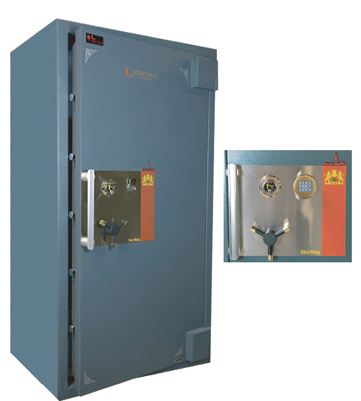Distinguishing Attributes of High Security Safes
 High security safes, in broad terms, are safes that provide above average or moderate protection. These are safes designed to resist attempts in forcibly opening them using mechanical or electrical tools. At the very least, they should effectively prevent burglars from opening them using lock picking tools, hammers, grinders, chisels, wheel cutters, power saws, or drills. However, some companies and security experts consider “high security” to mean a minimum of TRTL (torch and tool resistance) rating.
High security safes, in broad terms, are safes that provide above average or moderate protection. These are safes designed to resist attempts in forcibly opening them using mechanical or electrical tools. At the very least, they should effectively prevent burglars from opening them using lock picking tools, hammers, grinders, chisels, wheel cutters, power saws, or drills. However, some companies and security experts consider “high security” to mean a minimum of TRTL (torch and tool resistance) rating.
There is no agreed precise list of features that will make a safe something that can be considered “high security.” The phrase is mostly used for marketing. For this discussion, however, the minimum will be set at TRTL30 or torch and tool resistance for up to 30 minutes. This is the standard generally used by informative or encyclopedic sites that provide information about safes. Safes in the TL 30 and TL40 classes are considered moderation protection safes.
Torch Resistance
TR stands for torch resistance in the TRTL30 term. Torch resistance means being able to withstand the damaging effects of a blowtorch, specifically an oxy-fuel welding and cutting torch. It will not be common for burglars to carry a blowtorch with them but it is reassuring having a safe that can’t be easily broken into using a blowtorch or the more powerful oxy-gas torch.
It’s important to emphasize that torch resistance does not equate to fire resistance. Safes marketed as fire-resistant or fireproof are not necessarily torch resistant. However, many torch-resistant safes are fireproof and even waterproof. Fire resistant safes can still be easily damaged by an oxy-gas torch, especially on the sides if the protection is limited to the door.
Tool Resistance
The TL portion of the TRTL30 designation for safes, on the other hand, infers tool resistance. Just ignore the fact that it’s not exactly an acronym to avoid the confusion. Tool resistant safes are expected to prevent forcible opening using various tools including hand and electric drills, grinders, power saws, cutting wheels, carbide drills, and hammers or other objects that apply stress or pressure onto the safe.
Tool resistance infers durability and a solid build. However, you also have to take into account the weight or portability of the safe. It’s useless having a tool resistant safe that can be easily lifted up and taken away by a burglar. Consider screwing or solidly attaching relatively light TL safes to the floor or wall if they are not embedded to the wall or floor. Their “high security” nature is effectively rendered useless if they can be easily carried away by burglars.
If you are planning to buy a safe deemed highly secure, be sure to examine the unit for certifications or ascertain that the seller is reputable. Also, take note of the numbers in the names. The numbers indicate the maximum guaranteed protection time of a safe. A TRTL30 safe, for example, provides torch and tool resistance for up to 30 minutes only. Units with higher guaranteed times are usually thicker, bulkier, more durable, and more expensive.
